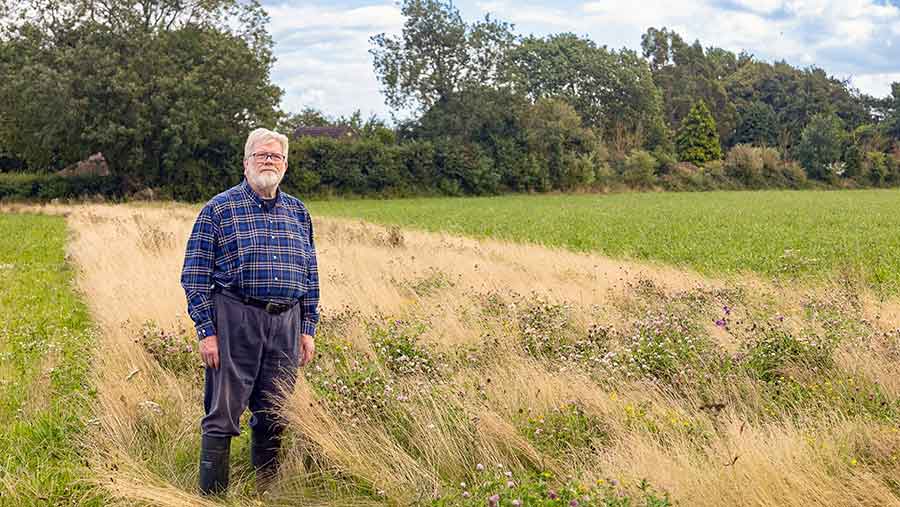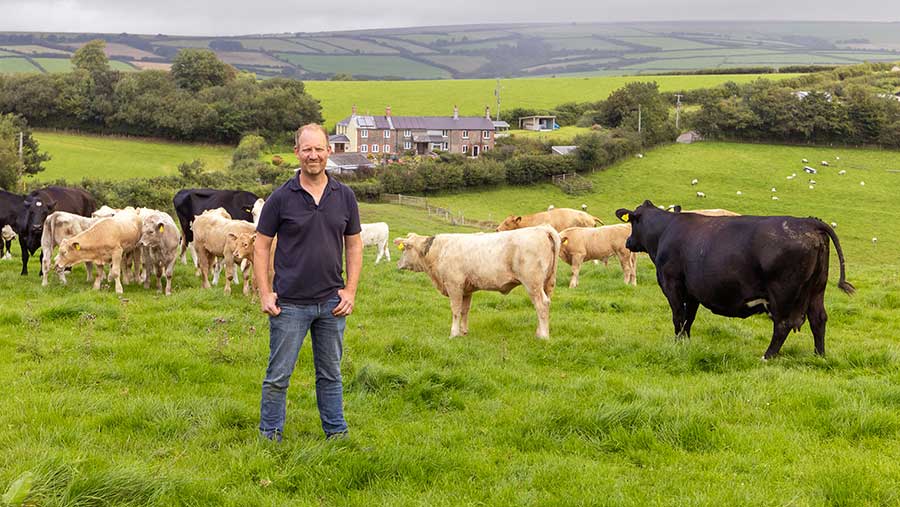Advertiser content
Farmers already benefiting from SFI income
Provided by
The Sustainable Farming Incentive (SFI) rewards farmers for farming practices that help produce food sustainably and protect the environment.
Find out how SFI can work for you.
Visit: gov.uk/future-farming
Livestock and arable farmers are already generating income through the Sustainable Farming Incentive, by adopting environmental practices that are also benefiting their business. So how are they finding it?
Paul Brown farms 77ha at Rookery Farm, Newbury, Berkshire, and signed up to the Sustainable Farming Incentive (SFI) in 2022.
Producing mostly milling wheat for breadmaking, he’s also in a mid-tier Countryside Stewardship agreement, and really liked the flexibility of the SFI scheme.
“There is a great range of options, it’s like pick and mix,” he says. “You can choose what suits you on your farm, without taking any land out of production.”
Paul found the online application easy to do himself, without the need to employ an agent to help. “It’s simple to do and doesn’t take long at all.”

Paul Brown © Defra
And the benefits are tangible, particularly as Basic Payments are reducing and phasing out.
“Quarterly payments help with cash flow and there’s no restriction with the amount of land you put into SFI.
“You’re getting more rewards for the natural capital and environmental enhancement you’re able to offer.”
According to AHDB analysis, implementing a range of SFI actions that do not require any land to be taken out of production – like managing hedgerows and testing soil organic matter – will increase a typical 455ha arable farm’s income by £15,000 a year.
Adding in actions that require some land use change – into flower-rich margins or buffer strips for example – will boost income by up to £36,000 a year.
And including some Countryside Stewardship options like protecting trees and woodland edges will increase returns by up to £46,000 a year.
When it comes to dairy farms, SFI actions which don’t require land to be taken out of production will boost a typical 105ha farm’s income by £6,300 a year.
Adding in other land use options increases that to £10,000 a year.
And with mixed beef and sheep units, those SFI actions not requiring land use change would boost a typical 220ha mixed farm income by up to £8,500 a year, with the latter increasing it by up to £14,500.
Tracey Langton, dairy and beef farmer in Derbyshire found the SFI 2023 online application easy, quick and straightforward to do.
“By cross referencing my field numbers with the handbook, I could easily see what options would work on my farm. We’ve received our first payment so we’re good to go.”
Many farmers are already implementing sustainable farming practices for which they could claim SFI payments, while others will see productivity benefits from doing so.
Examples include payments to improve animal health and welfare – including through free vet visits – optimising input use and making better use of natural resources.
Ian May keeps beef and sheep at Lambscombe Farm, on Exmoor, and participated in the SFI pilot as well as the 2022 and 2023 schemes. “I’m looking to build a business that’s resilient for the long term. SFI helps you do that,” he says.
“SFI is a way of getting some recognition for maintaining your land, soils and hedgerows. And it’s great that they’ve raised the payments for unimproved land.”

Ian May © Defra
The flexible approach means farmers can choose when to apply and start on the scheme – there’s no single annual deadline. “You can start up very quickly and easily.”
Find out how SFI works for you. Go to gov.uk/future-farming
Suggested entry-level SFI actions for arable and livestock farmers
Soil
Easy actions that can improve soil resilience and productivity while also benefiting the environment
-
SAM1 – Assess soil, test soil organic matter and produce a soil management plan. Payment: £6/ha plus £97 per agreement.
-
SAM2 – Multi-species winter cover crops. Payment: £129/ha
-
SAM3 – Herbal leys. Payment: £382/ha
Hedgerows
Easy actions which don’t take land out of production and benefit the environment
-
HRW1 – Assess and record hedgerow condition. Payment: £5 per 100m – one side
-
HRW2 – Manage hedgerows. Payment: £13 per 100m – one side
-
HRW3 – Maintain or establish hedgerow trees. Payment: £10 per 100m – both sides
Total: Up to £46 per 100m of hedgerow
As well as soils and hedgerows there are 17 further actions to choose from. Combining different options will maximise SFI income.
